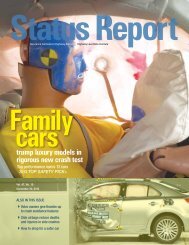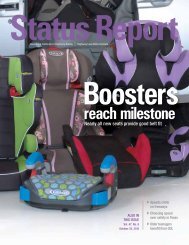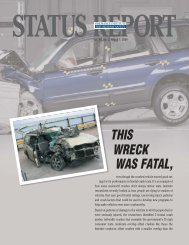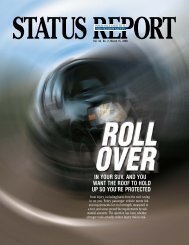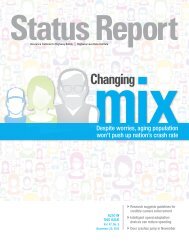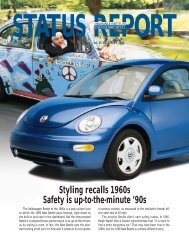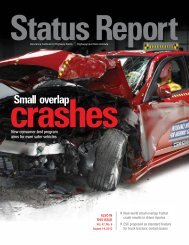4 <strong>Status</strong> <strong>Report</strong>, <strong>Vol</strong>. <strong>45</strong>, <strong>No</strong>. 3, <strong>March</strong> <strong>31</strong>, <strong>2010</strong>New Jersey Leadsway with strongteen licensING lawsTeenagers in New Jersey have to wait untilthey’re 17 to get their licenses, and thenthey have to adhere to tough restrictionsdesigned to help improve their driving whileminimizing risks. These policies are payingoff. A new AAA Foundation for Traffic Safetystudy reveals significant reductions in thecrash rates of 17 and 18 year-olds plus eliminationof most crashes of 16 year-olds.Most states license at 16, 16 -1/2, or somewherein between, and a few license evenyounger. Only New Jersey has had a law inplace for decades that puts off licensure until17, which is more in line with policies incountries other than the United States.New Jersey’s graduated licensing program,begun in 2001, puts this state among34 with laws that meet or exceed most Institutebenchmarks for an optimal program exceptthat it notably lacks a nighttime drivingprovision that begins at 9 or 10 pm insteadof later. States with such programs experienceboth lower fatal crash rates among teendrivers and lower rates of insurance claims,compared with states with weaker laws.Only New Jersey applies all of its graduatedlicensing provisions to beginnersyounger than 21. Teens who enter the licensingsystems in nearly every other statebefore they’re 18 graduate from the restrictionsonce they turn 18, and the laws in moststates don’t apply at all to older beginners.Beginners in New Jersey spend at least6 months in the learner’s stage and must be17 to get provisional licenses. Nighttime andpassenger restrictions apply for a year, effectivelymaking 18 the minimum age for anunrestricted license. For people 17-20, boththe learner and provisional stages havenighttime driving restrictions and passengerlimits. Cellphones and other electronicdevices are banned for beginners of all ages,and all occupants must use safety belts.“New Jersey shows that licensing later andand then restricting driving by beginners producessafer drivers who are less prone tocrashing,” says Allan Williams, former Institutechief scientist and lead author of the AAAreport. “Teenagers accrue an extra year ofmaturity before getting behind the wheel andaccumulate on-the-road experience in more favorableconditions. It’s the right combination.”Williams’ study is first to take a comprehensivelook at the combined effects of delayedlicensure and a graduated system thatapplies to all beginners. His research teamcompared crash rates among various agegroups before and after graduated licensingbegan in 2001. Data are from the federalFatality Analysis <strong>Report</strong>ing System and NewJersey records of police-reported crashes.Crash rates among drivers 17 years old,the main beneficiaries of graduated licensing,fell 16 percent in New Jersey after thelaw took effect, relative to crashes of drivers25-59 years old. Fatal crashes per 100,000population declined 25 percent, and injurycrashes per 1,000 population fell 14 percent.Nighttime crashes of 17 year-olds tumbled44 percent, compared with drivers 25-59,after the 2001 law banned beginners fromdriving between midnight and5 am. Before this law,New Jersey ranked<strong>45</strong>th among 51 jurisdictionsin terms of 17year-olds’ fatal crash rates. Afterthe law, the ranking improved to 21st.Williams points out that 15 of the20 states ranking ahead of New Jerseysubject some or all of their 17year-olds to graduated licensing.While other states except Marylanddon’t touch 18 year-olds with driving restrictions,New Jersey’s law benefits driversthis age. The overall crash rate of 18 yearoldsfell 10 percent after the 2001 law. Injurycrashes also fell 10 percent, while crashesamong 16-year-old drivers werelargely eliminated.A concern about postponinglicensure until 17 has beenthat this just delays the riskassociated with beginners,offsetting any safety benefitsof later licensing by elevating17 year-olds’ crash rates, but this hasn’tbeen the case in New Jersey.<strong>No</strong>w the state’s legislators are strengtheningrestrictions on nighttime driving andpassengers. Beginning May 1, the nighttimerestriction will start at 11 pm instead of midnight,and beginners won’t be allowed todrive with passengers other than their dependents.Another new restriction involvesreflective decals on the license plates,both front and rear, of vehicles drivenby people who are younger than 21.The idea is to help police enforcegraduated licensing restrictionsby identifying learners andprovisional licensees.“Evaluation of New Jersey’sGraduated LicensingProgram” by A. F.Williams et al., appearsin the Feb.22, <strong>2010</strong>, issueof Traffic InjuryPrevention.
<strong>Status</strong> <strong>Report</strong>, <strong>Vol</strong>. <strong>45</strong>, <strong>No</strong>. 3, <strong>March</strong> <strong>31</strong>, <strong>2010</strong> 5helmet USE LAWS that APPlyTO ALL RIDERS TRIM LIKELIHOODOF MOTORCYCLE CRASH INJuryMotorcyclists in states that require all riders to wear helmets are lesslikely to file insurance claims for medical treatment after collisions,compared with riders in states without helmet laws or where the lawsapply to some but not all riders. This is the main finding of a newstudy by the Institute-affiliated Highway Loss Data Institute (HLDI).Twenty states require all motorcyclists to wear helmets, 27 targetthe laws at younger riders, and 3 states (Illinois, Iowa, and NewHampshire) don’t have helmet laws at all. HLDI compared the riskof injury claims, given collision claims, for riders in these groups ofstates, finding the lowest risk under the universal laws. Injury risk was3 percent higher in states with laws applying to some riders and 6percent higher in states without helmet laws. Injury risk was 4 percenthigher among riders older than 21 in states where these riders aren’trequired to wear helmets.The study includes collision and medical payment claims data associatedwith 2001-09 model motorcycles involved in crashes in allbut a few states during 2002-09. Collision coverage, which insuresagainst damage to a motorcycle, generally applies when a rider is atfault. Medical payment covers the medical costs of injured riders upto policy limits. Overall, more than half of collision claims resulted inassociated medical payment claims. HLDI’s database doesn’t includeHELMET USE IS VIRTUALLY UNIVERSAL IN STATESTHAT REQUIRE HELMETS ON ALL RIDERS. THE USERATE IS ABOUT 50 PERCENT WITHOUT SUCH LAWS.information about the types of injuries associated with such claims orwhether riders were wearing helmets when they crashed.Helmets are the principal countermeasure for reducing head injuries,the leading cause of death among unhelmeted riders. Theyreduce the likelihood of death by 37 percent. Without them, motorcyclistsare 3 times as likely as helmeted riders to suffer traumaticbrain injuries. Yet many motorcyclists refuse to wear a helmet if it’snot illegal to ride without one.Nearly all riders wear helmets in states with universal laws, but requiringhelmets on some riders doesn’t boost use rates or rider safetynearly as much. Helmet use is about half in states that don’t havehelmet laws or that apply their laws only to younger riders.For a copy of “Helmet use laws and medical payment injury riskfor motorcyclists with collision claims,” write: Publications, HighwayLoss Data Institute, 1005 <strong>No</strong>rth Glebe Rd., Arlington, VA 22201; oremail publications at iihs.org.



